

TODAY'S ISSUE
TODAY’S DAILY DOSE OF DATA SCIENCE
4 Stages of Training LLMs from Scratch
Today, we are covering the 4 stages of building LLMs from scratch that are used to make them applicable for real-world use cases.
We’ll cover:
- Pre-training
- Instruction fine-tuning
- Preference fine-tuning
- Reasoning fine-tuning
The visual summarizes these techniques.
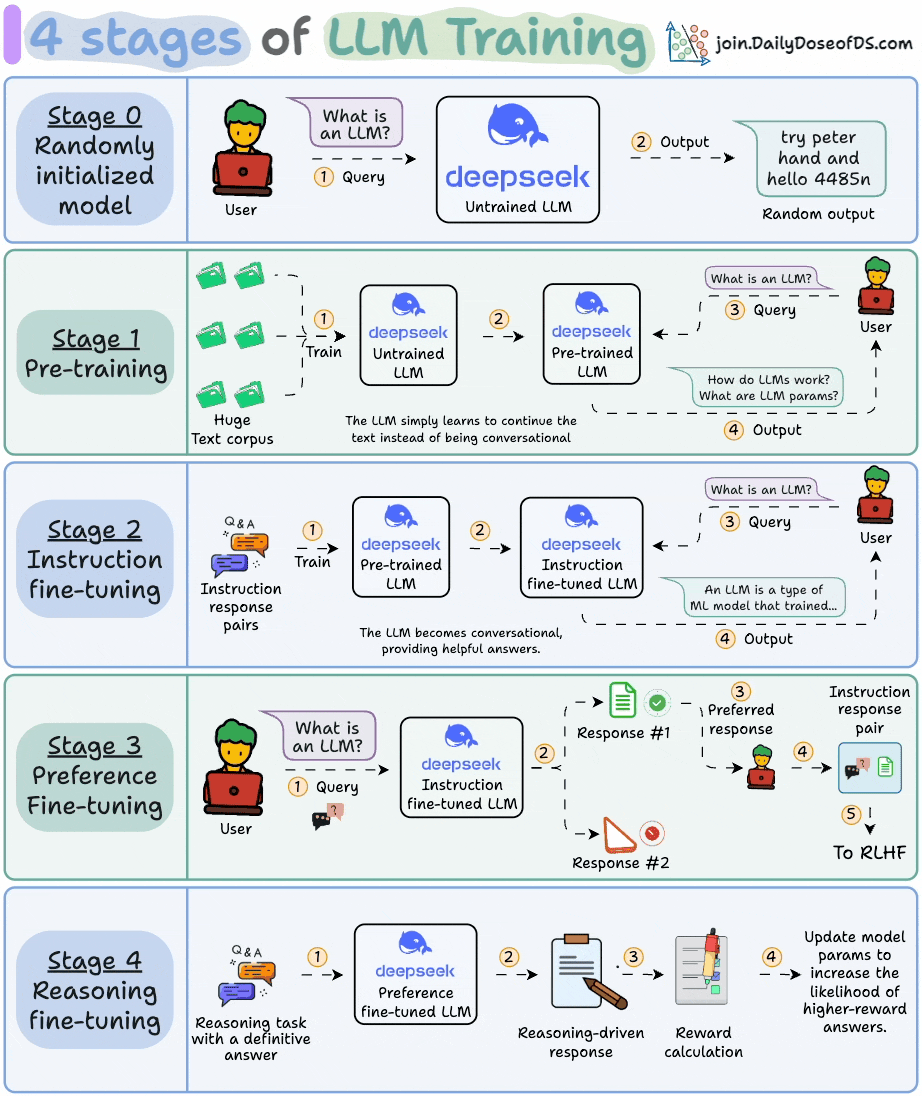
Let's dive in!
0️⃣ Randomly initialized LLM
At this point, the model knows nothing.
You ask it “What is an LLM?” and get gibberish like “try peter hand and hello 448Sn”.
It hasn’t seen any data yet and possesses just random weights.
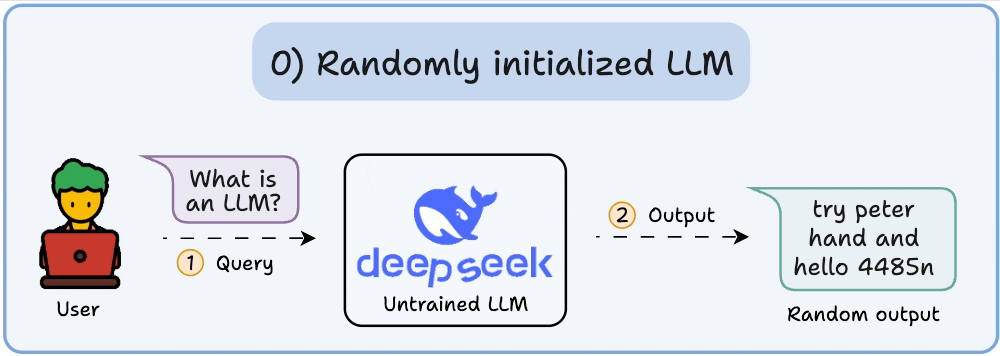
1️⃣ Pre-training
This stage teaches the LLM the basics of language by training it on massive corpora to predict the next token. This way, it absorbs grammar, world facts, etc.
But it’s not good at conversation because when prompted, it just continues the text.
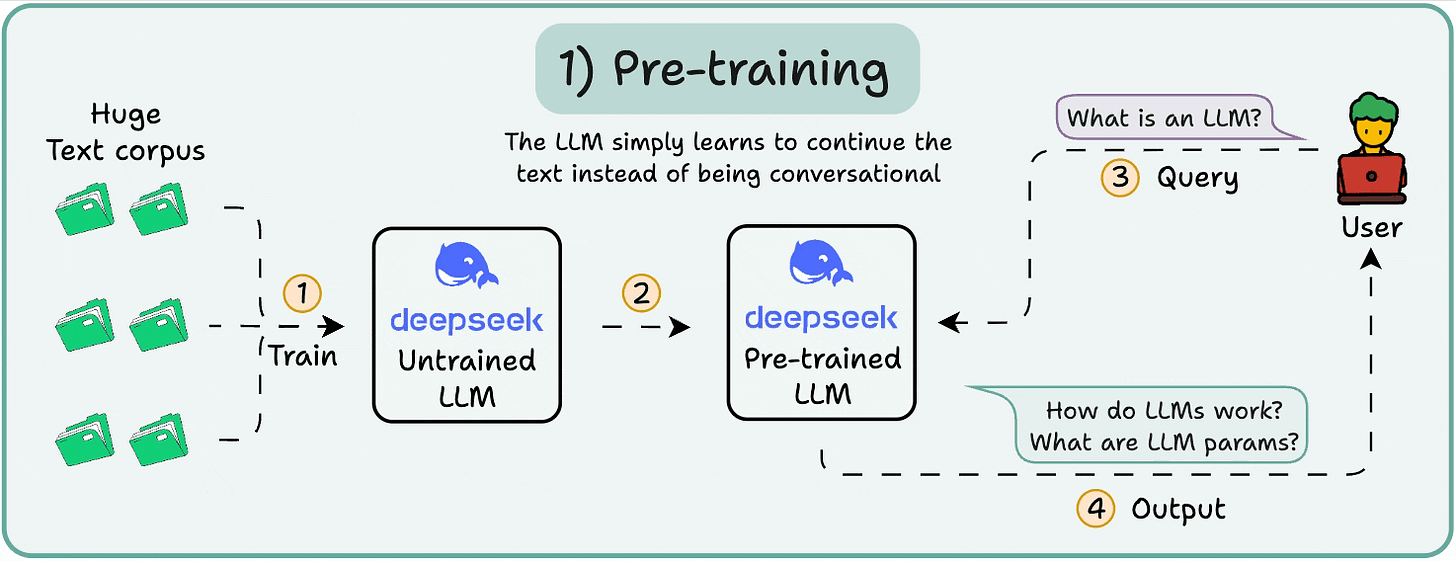
We implemented pre-training of Llama 4 from scratch here →It covers:- Character-level tokenization- Multi-head self-attention with rotary positional embeddings (RoPE)- Sparse routing with multiple expert MLPs- RMSNorm, residuals, and causal masking- And finally, training and generation.
2️⃣ Instruction fine-tuning
To make it conversational, we do Instruction Fine-tuning by training on instruction-response pairs. This helps it learn how to follow prompts and format replies.
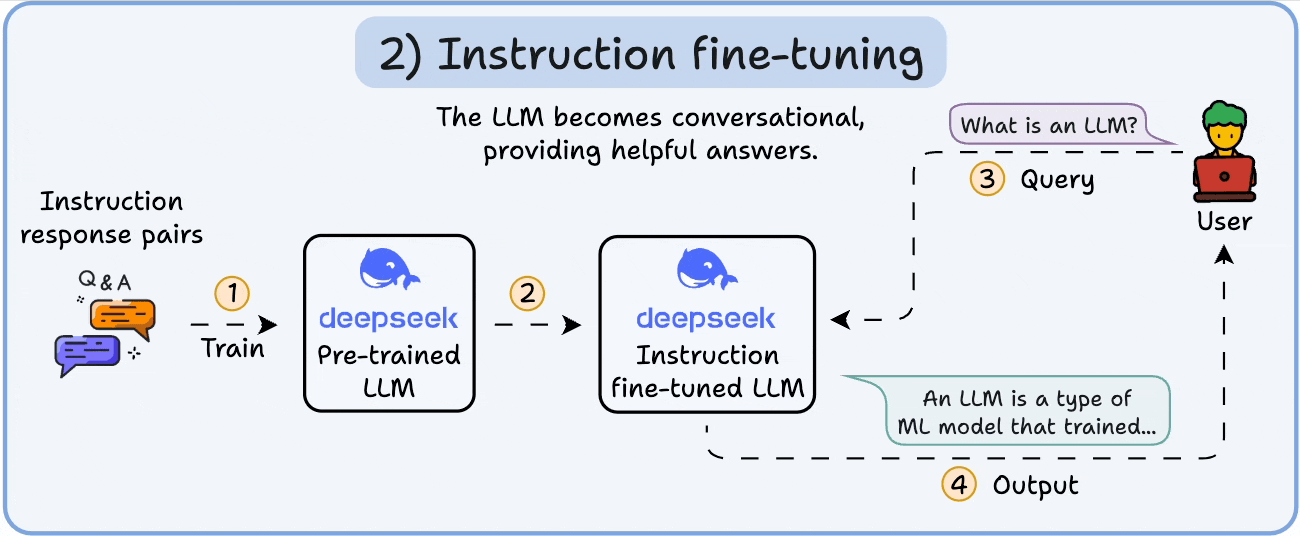
Now it can:
- Answer questions
- Summarize content
- Write code, etc.
At this point, we have likely:
- Utilized the entire raw internet archive and knowledge.
- The budget for human-labeled instruction response data.
So what can we do to further improve the model?
We enter into the territory of Reinforcement Learning (RL).
3️⃣ Preference fine-tuning (PFT)
You must have seen this screen on ChatGPT where it asks: Which response do you prefer?
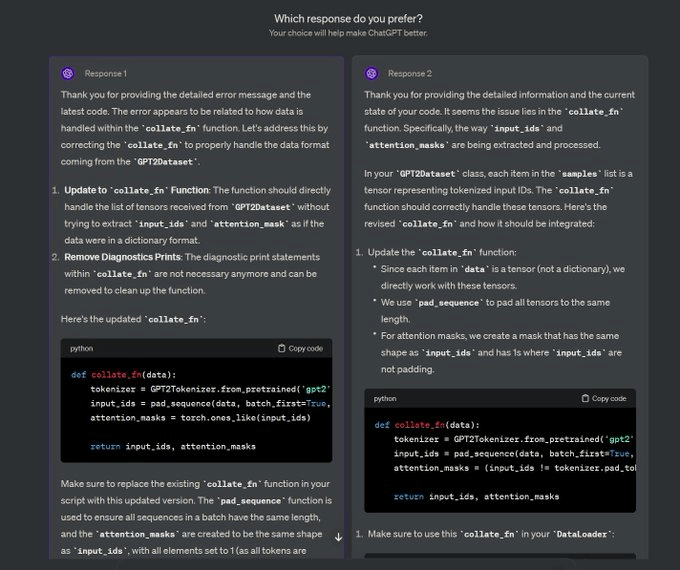
That’s not just for feedback, but it’s valuable human preference data.
OpenAI uses this to fine-tune their models using preference fine-tuning.
In PFT:
The user chooses between 2 responses to produce human preference data.
A reward model is then trained to predict human preference and the LLM is updated using RL.
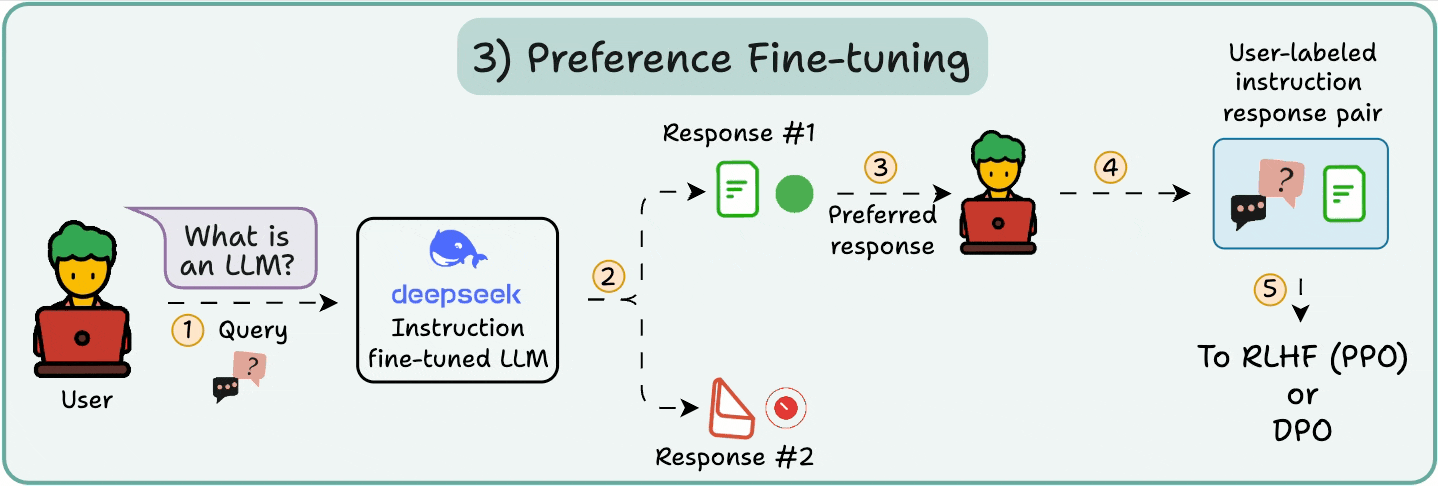
The above process is called RLHF (Reinforcement Learning with Human Feedback), and the algorithm used to update model weights is called PPO.
It teaches the LLM to align with humans even when there’s no "correct" answer.
But we can improve the LLM even more.
4️⃣ Reasoning fine-tuning
In reasoning tasks (maths, logic, etc.), there's usually just one correct response and a defined series of steps to obtain the answer.
So we don’t need human preferences, and we can use correctness as the signal.
This is called reasoning fine-tuning

Steps:
- The model generates an answer to a prompt.
- The answer is compared to the known correct answer.
- Based on the correctness, we assign a reward.
This is called Reinforcement Learning with Verifiable Rewards. GRPO by DeepSeek is a popular technique for this.
Those were the 4 stages of training an LLM.
- Start with a randomly initialized model.
- Pre-train it on large-scale corpora.
- Use instruction fine-tuning to make it follow commands.
- Use preference & reasoning fine-tuning to sharpen responses.
In a future issue, we shall dive into the specific implementation of these.
In the meantime, read this where we implemented pre-training of Llama 4 from scratch here →
It covers:
- Character-level tokenization
- Multi-head self-attention with rotary positional embeddings (RoPE)
- Sparse routing with multiple expert MLPs
- RMSNorm, residuals, and causal masking
- And finally, training and generation.
Hands-on
Tool calling in LLMs

Printing the response, we get:

Notice that the message key in the above response object has tool_calls, which includes relevant details, such as:
tool.function.name: The name of the tool to be called.tool.function.arguments: The arguments required by the tool.
Thus, we can utilize this info to produce a response as follows:

This produces the following output.
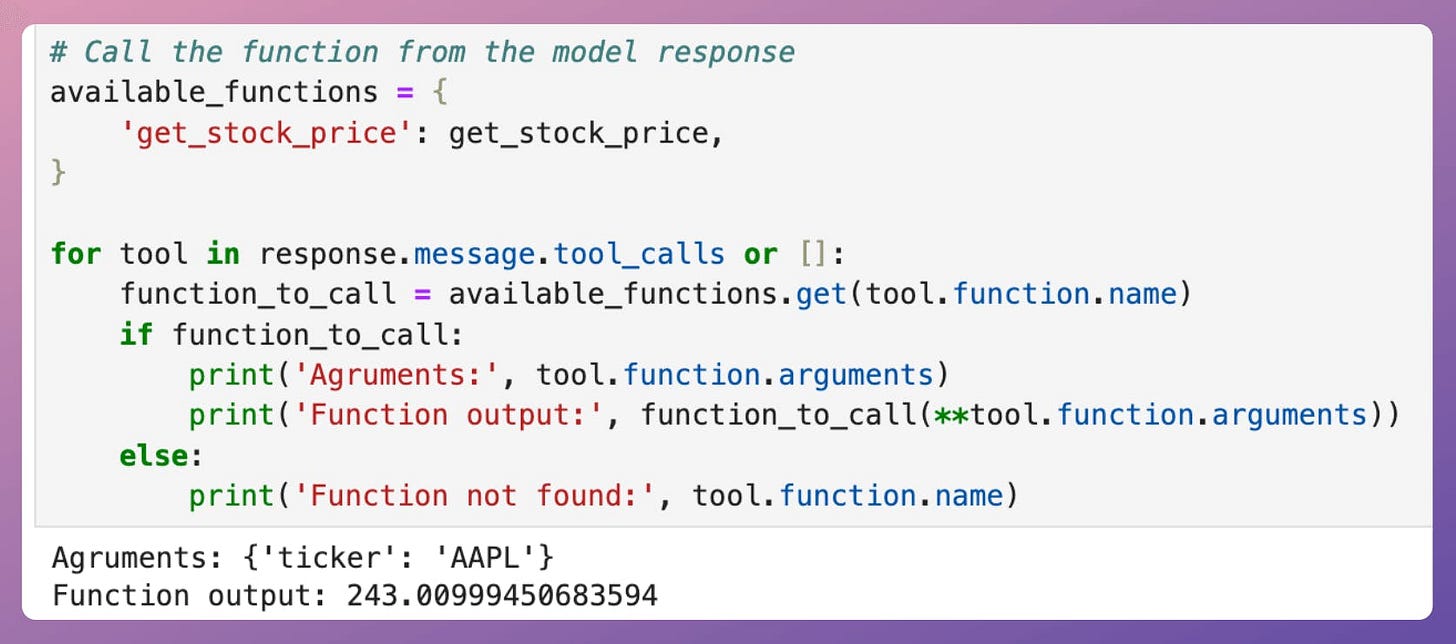
This produces the expected output.
Of course, the above output can also be passed back to the AI to generate a more vivid response, which we haven't shown here.
But this simple demo shows that with tool calling, the assistant can be made more flexible and powerful to handle diverse user needs.
👉 Over to you: What else would you like to learn about in LLMs?
MODEL OPTIMIZATION
Model compression to optimize models for production
Model accuracy alone (or an equivalent performance metric) rarely determines which model will be deployed.
Much of the engineering effort goes into making the model production-friendly.
Because typically, the model that gets shipped is NEVER solely determined by performance — a misconception that many have.

Instead, we also consider several operational and feasibility metrics, such as:
- Inference Latency: Time taken by the model to return a prediction.
- Model size: The memory occupied by the model.
- Ease of scalability, etc.
For instance, consider the image below. It compares the accuracy and size of a large neural network I developed to its pruned (or reduced/compressed) version:
Looking at these results, don’t you strongly prefer deploying the model that is 72% smaller, but is still (almost) as accurate as the large model?
Of course, this depends on the task but in most cases, it might not make any sense to deploy the large model when one of its largely pruned versions performs equally well.
We discussed and implemented 6 model compression techniques in the article here, which ML teams regularly use to save 1000s of dollars in running ML models in production.
Learn how to compress models before deployment with implementation →
THAT'S A WRAP
No-Fluff Industry ML resources to
Succeed in DS/ML roles

At the end of the day, all businesses care about impact. That’s it!
- Can you reduce costs?
- Drive revenue?
- Can you scale ML models?
- Predict trends before they happen?
We have discussed several other topics (with implementations) in the past that align with such topics.
Here are some of them:
- Learn sophisticated graph architectures and how to train them on graph data in this crash course.
- So many real-world NLP systems rely on pairwise context scoring. Learn scalable approaches here.
- Run large models on small devices using Quantization techniques.
- Learn how to generate prediction intervals or sets with strong statistical guarantees for increasing trust using Conformal Predictions.
- Learn how to identify causal relationships and answer business questions using causal inference in this crash course.
- Learn how to scale and implement ML model training in this practical guide.
- Learn 5 techniques with implementation to reliably test ML models in production.
- Learn how to build and implement privacy-first ML systems using Federated Learning.
- Learn 6 techniques with implementation to compress ML models.
All these resources will help you cultivate key skills that businesses and companies care about the most.
SPONSOR US
Advertise to 600k+ data professionals
Our newsletter puts your products and services directly in front of an audience that matters — thousands of leaders, senior data scientists, machine learning engineers, data analysts, etc., around the world.






